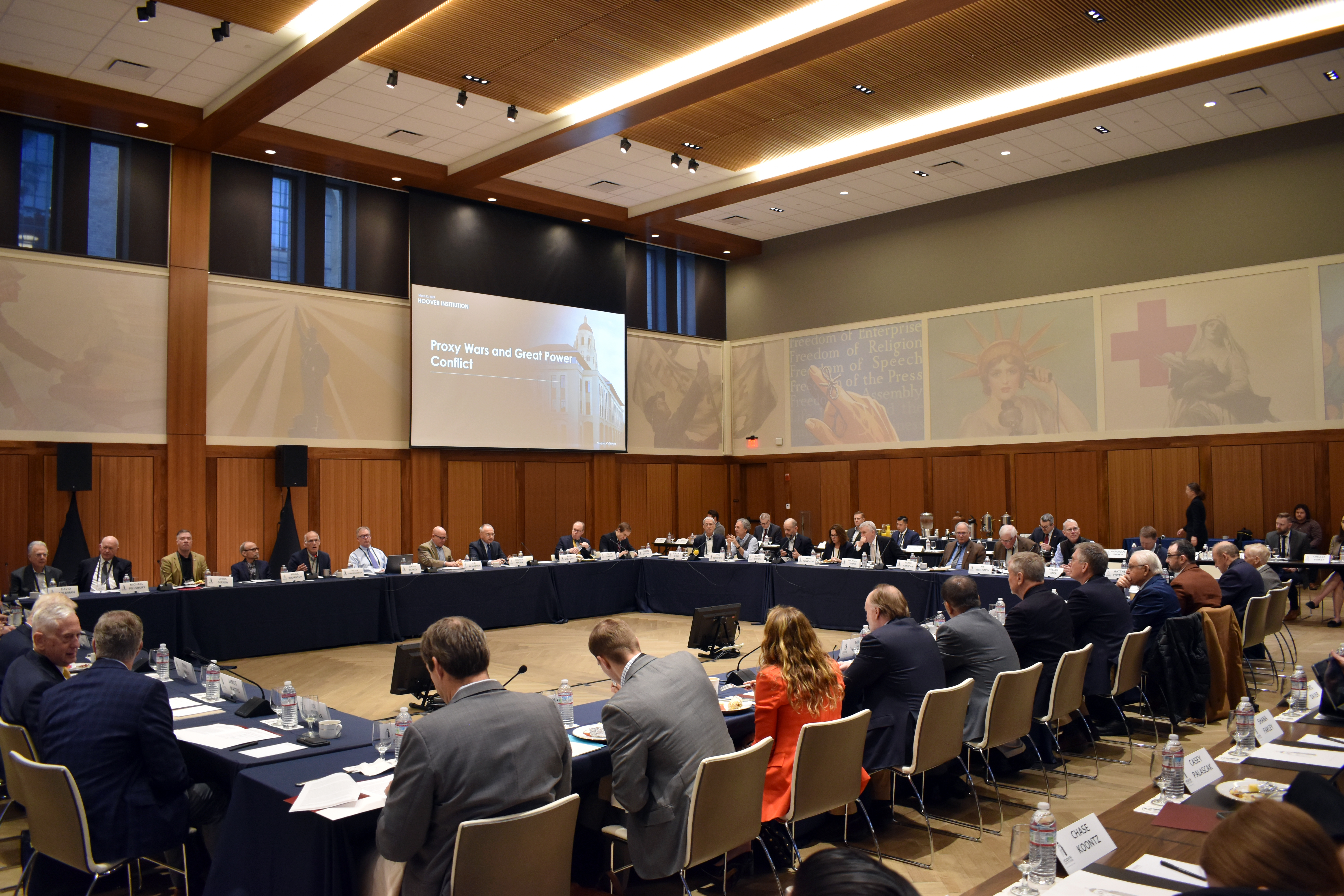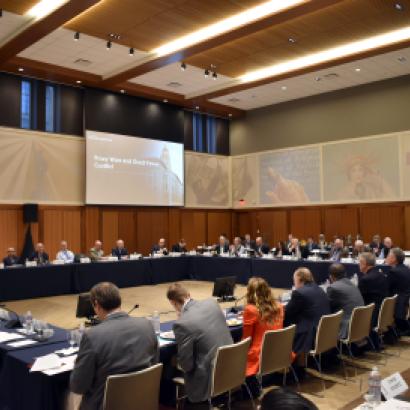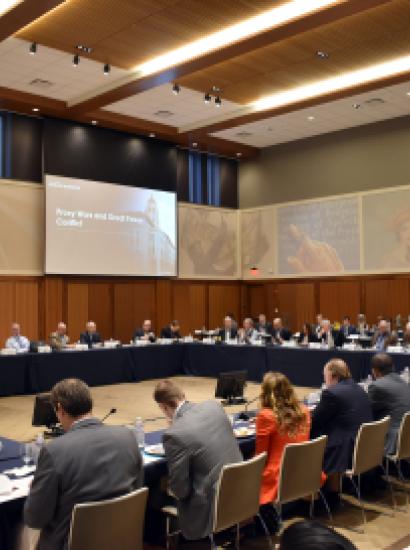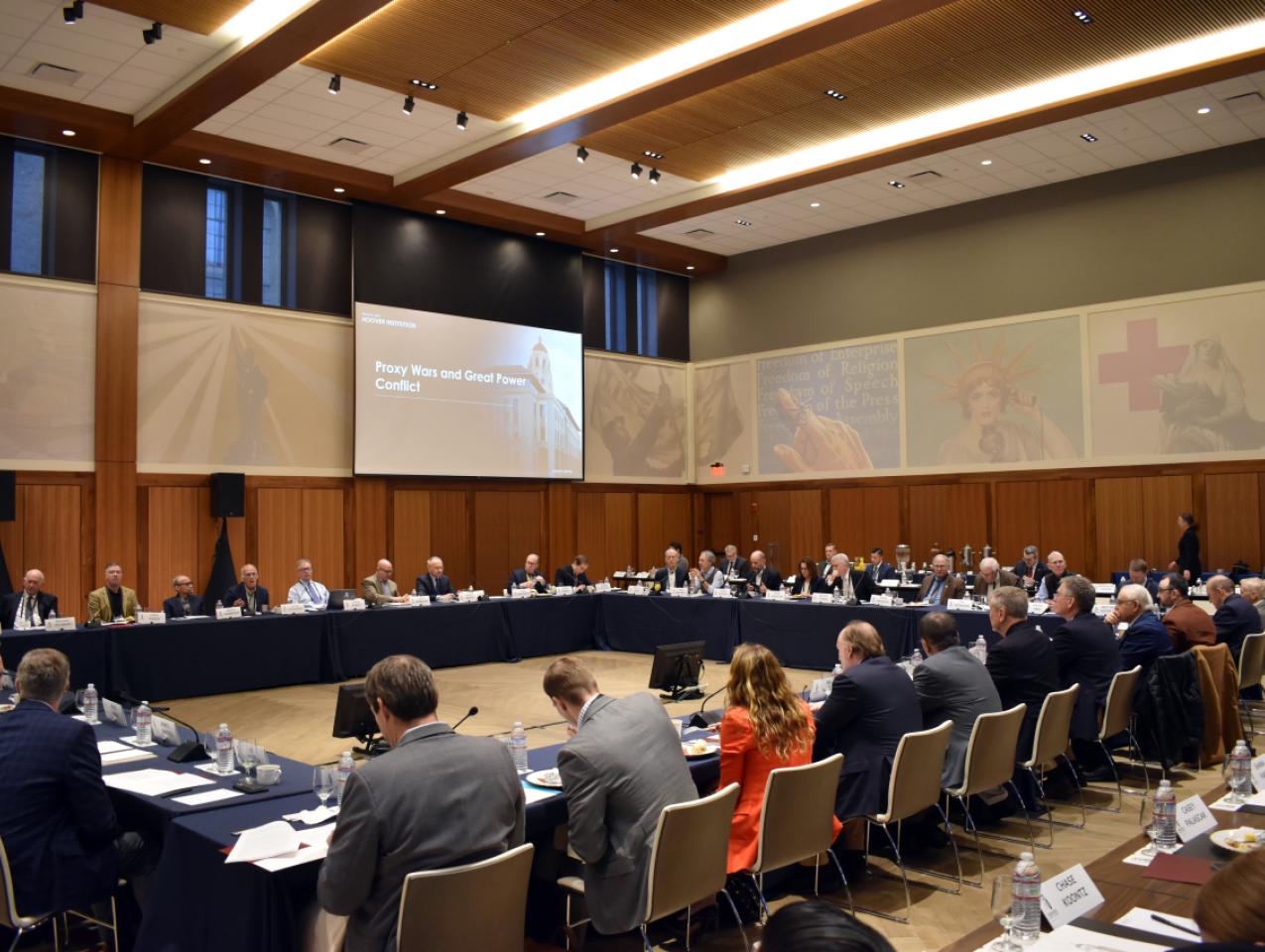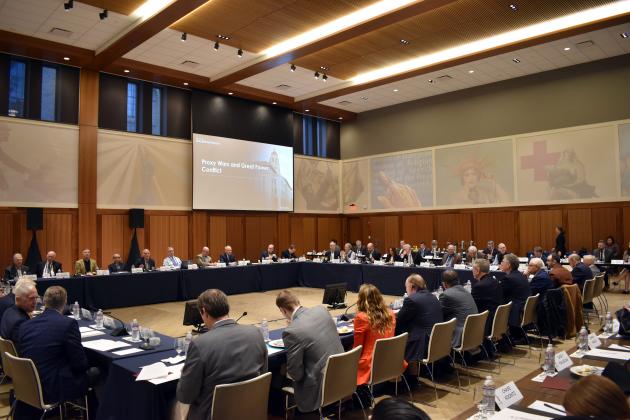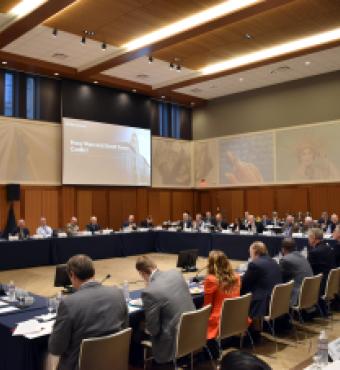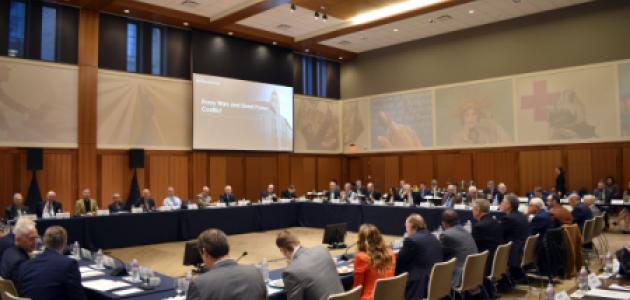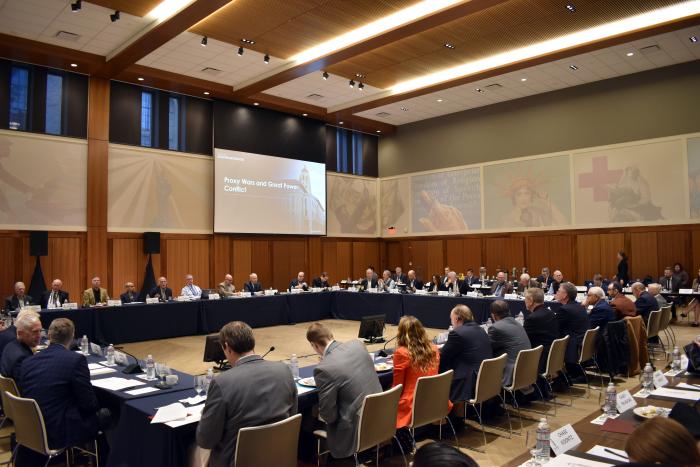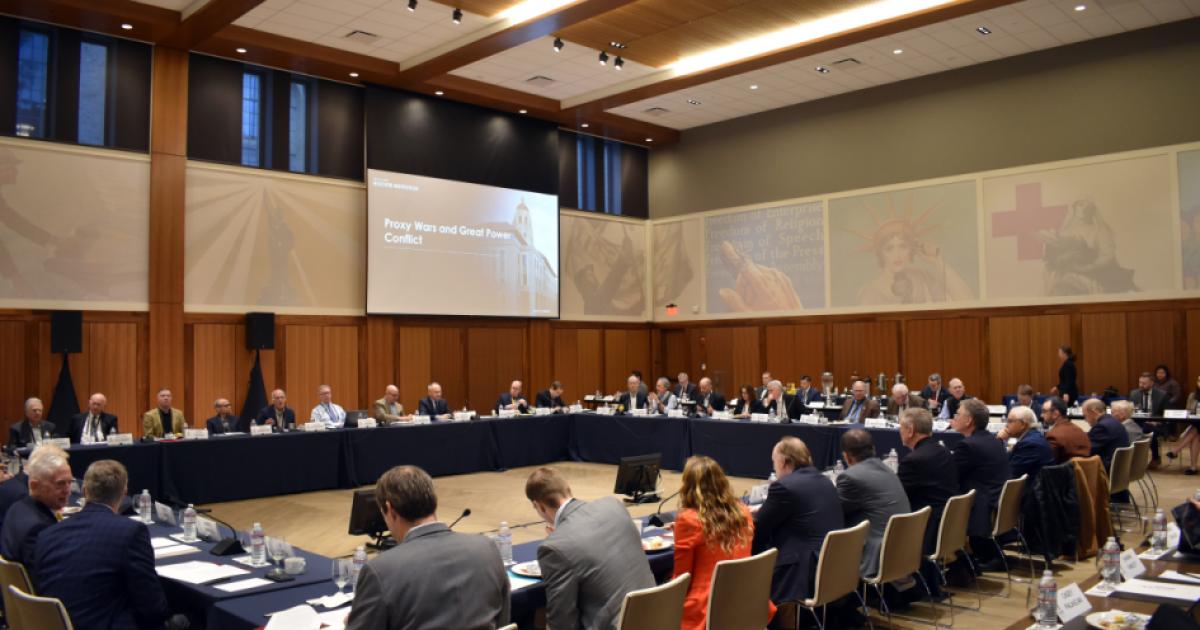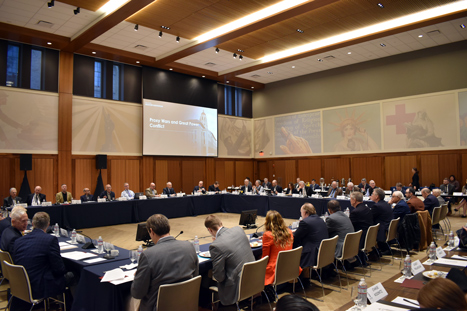Hoover Institution (Stanford, CA) – Hoover fellows and scholars affiliated with the institution’s Military History in Contemporary Conflict Working Group explored the history and use of proxy wars, and what they mean for modern great-power competition, at a conference on March 22, 2024.
The group talked about proxy wars dating back to ancient Greece, how they led to larger major global conflicts in history, the US experience with proxy wars, and the status of conflicts in Ukraine and Gaza and with Iran’s proxies across the Middle East.
The workshop was chaired by Martin and Illie Anderson Senior Fellow Victor Davis Hanson, and organized by Research Fellow David Berkey and Senior Program Manager Megan Ring.
The workshop featured four presentations: “The Origins and Rules of Proxy Wars,” by Visiting Fellow Paul Rahe; “Proxy Wars and Cold War Superpowers,” by Distinguished Visiting Fellow Josef Joffe; “Post–World War II and Middle East Proxy Wars,” with Michael Doran; and “Ukraine and Gaza,” by Center for Naval Analysis senior research scientist Michael Kofman and Tad and Dianne Taube Senior Fellow Peter Berkowitz.
What Is a Proxy War?
Simply put by the Oxford Dictionary, a proxy war is a “war instigated by a major power which does not itself become involved.”
But, as Paul Rahe explained, not all proxy wars follow that format.
The workshop began with a look at historical proxy wars, focusing in on one such conflict, the Sicilian Expedition of 415 BC, in which Sparta used Syracuse as a proxy to wage war against Athens and Segesta on the island of Sicily.
Proxy wars have come a long way since then, but many of the elements remain the same. Indirect participants can supply arms, money, or actual combatants to the proxy conflict.
These positive reinforcements to influence the conduct of their proxy faction might be complemented or replaced by negative reinforcements, such as using force to compel the proxy to behave the way the major power sees fit.
Throughout the day, participants floated competing definitions of what a proxy war is and when they arise.
One workshop participant suggested that a proxy war is an indirect conflict between two great powers, using smaller states or movements to do the fighting in a less escalatory, possible smaller-scale environment.
Another individual suggested that proxy wars are cheaper and safer ways for major powers to inflict pain on one another as opposed to all-out conflict, especially in the nuclear age.
Participants examined the following questions in determining the characteristics of such conflicts:
Are most proxy wars the product of two smaller states entering into armed conflict, with larger outside players subsequently picking sides because the war outcome will advance their strategic interests? Or are proxy wars most often fought when two great powers are engaged in a strategic rivalry and reach a stalemate, but not wanting to escalate to a state of total war, pick smaller aligned states and encourage them to fight instead?
When is a conflict participant a partner or ally? Does a proxy become a partner or ally when it begins engagement in a war?
The scholars also discussed how the Cold War saw a plethora of proxy wars erupt across the globe between communist and capitalist movements. Major ones included the Korean War, the Vietnam War, the Soviet invasion of Afghanistan, and the Angolan Civil War, but there were dozens of smaller conflicts between 1946 and 1991 that qualified as proxy wars.
Do Proxy Wars Work?
In asking whether proxy wars work, attendees replied, in short: yes, but also no.
They work if the outside player can keep control of its proxy, if they can provide stable and ample funding to the proxy, and if they have a well-defined end objective. But such wars can be extremely costly and can also widen into general wars between great powers.
One attendee observed that proxy wars work best when the fighting occurs near an area that could be considered a sanctuary—a region that an opponent would consider too high-risk to deploy its own troops.
Modern examples of sanctuaries include China for the United States during the Korean War; Pakistan for both Soviet and US troops during their respective deployments in Afghanistan; Syria and Iran for US troops during the Iraq War; and Poland for Russian forces in the current Ukraine war.
In each of those instances, the safe adjacent sanctuary territory allowed the proxy a virtually indestructible ability to regenerate and resupply their forces. During the Korean War, North Korean troops could slip into China to avoid being targeted by UN forces. During the Afghanistan campaign, Taliban fighters could retreat into Pakistan to regroup and rearm, with little risk of Pakistani or US pursuit.
Suggestions were made that conflicts such as the Spanish Civil War and the Japanese invasion of Manchuria in the 1930s set the stage for wider confrontations such as the Second World War.
Also mentioned was the fact that the United States itself was once a proxy—fighting for its own independence from Britain with the support of France. Moreover, there were more French soldiers and sailors present at the Battle of Yorktown (1781) than Continental Army troops. In this sense, American troops served as a proxy in the great-power competition between France and Britain.
Today, the United States is engaged in multiple proxy wars: supplying arms to the Ukrainians to repel and degrade the Russian military; supplying arms to Israel so it can dismantle Hamas (an Iranian proxy); and directly confronting a wider array of Iranian proxies in Syria, Iraq, and the Red Sea.
Regarding US engagement in proxy conflicts, some speakers noted that American administrations have unique challenges in prosecuting them.
Unlike authoritarian powers of today such as Russia or China, the United States must justify to its voting public not only the strategic value but also the moral imperative of engaging in such a conflict.
Several attendees said having to argue for the moral good of engaging in such proxy conflicts holds the United States back, compared with its great-power rivals.
Building on this idea, another attendee said that US officials need to better shape the public narrative when engaging in proxy conflicts, especially in online contexts, as it often cedes the argument to voices from its rivals.
Proxy Wars of Today: Iran, Ukraine, and Gaza
Toward the end of the day, attendees heard from Michael Kofman. He provided a detailed outline of the status of the Russia-Ukraine War, including its immediate challenges for both states.
Attendees heard that while the outcome of the Russian invasion of Ukraine is not yet determined, it is dependent on several hard choices the Ukrainians, the European Union, and the United States must make in the next three to six months.
Attendees also heard from Peter Berkowitz on the status of the conflict in Gaza.
Berkowitz reviewed the stages of the conflict to date—from the initial days after the Hamas attack on October 7, 2023, to the estimated combatant and civilian losses inside Gaza since Israeli troops began their incursion.
He criticized the Israeli government for its poor preparation of defenses along the Gaza border fence and its decision to permit Hamas to operate relatively unimpeded prior to last year’s attack.
In terms of solutions, he said the “least bad option” would be some combination of support from Saudi Arabia and the United Arab Emirates in funding a massive reconstruction effort in Gaza while simultaneously helping stand up a local Palestinian leadership apparatus, with Israel retaining the security responsibility for the area.
Others commented that it might be up to twenty years before Gaza has any sort of effective local governance, based on the amount of damage and upheaval it has seen in the last six months.
The situation of Iran and its proxies, and how the United States must contend with them, weaved its way through the day’s discussion.
Several speakers argued that the current US administration has engaged in “strategic timidity” when confronting Iranian proxies such as the Houthi movement, Hezbollah, and the Popular Mobilization Forces of Iraq.
Some participants said that the United States shouldn’t assume that Iran would be deterred by strikes on its proxy forces. They maintained that a more effective deterrence strategy would be to target Iranian advisors and suppliers supporting those proxies in the Middle East.
They also criticized the Biden administration’s continued hopes that Iran will return to multilateral negotiations regarding its nuclear ambitions. They cited this hope for a deal as characteristic of the irresolution of the Biden White House when it considers direct military retaliation against Iran in response to the actions of its proxies.







